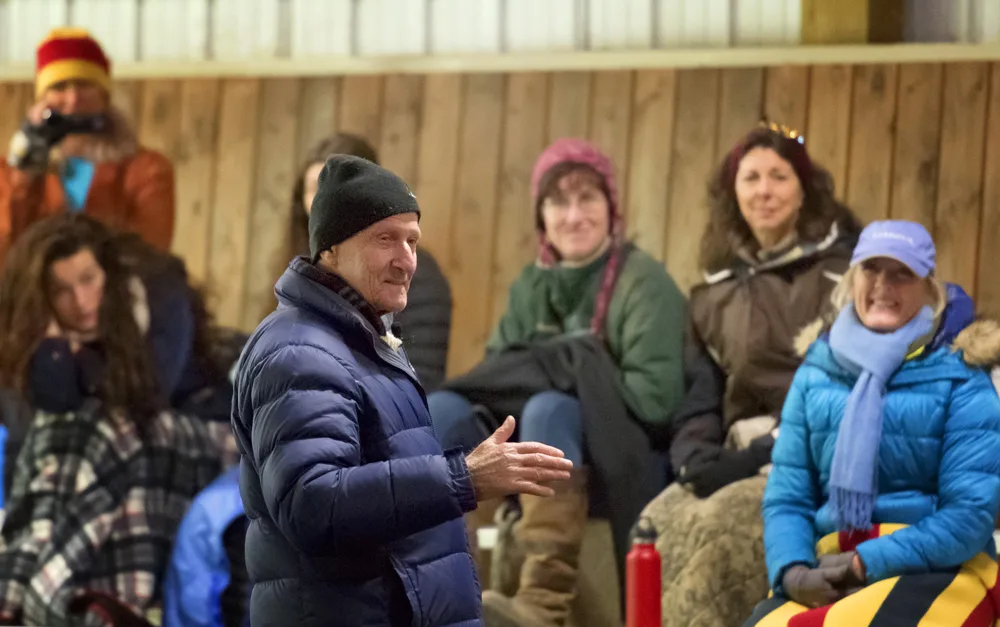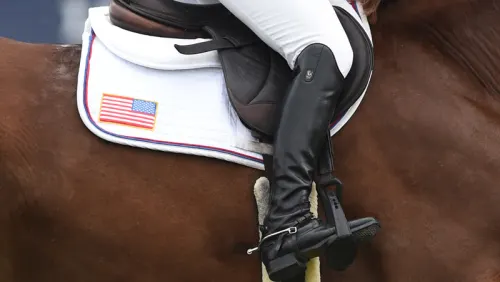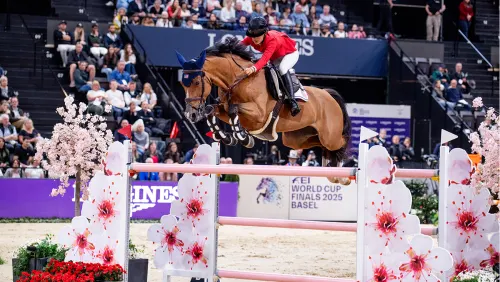If there’s one thing that will motivate a rider to stay out in the corner it is George Morris standing just inside that corner.
No one wants to be the rider that takes out George Morris.
The last day of the three-day clinic (read all about Day 2) at Rich Fellers’ Timberline Meadows in Oregon had riders working on their turns and reinforcing the principles of riding under Morris’ watchful eye.
Morris cautioned that the nature of a clinic is that it is very short; what you get in the clinic is the idea and then you take it home to instill it.
He also reminded riders and auditors that he takes clinics seriously. It’s not about the social aspects, he told his listeners—while simple, riding is still a dangerous sport.
One of the ideas Morris worked on with riders from the 3’6” level to the 4’3” and above group was to let go in order to see your distance. “People love control,” he said, as he pointed out the correct approach to three fences three strides apart. To see the distance the riders needed to stay out in the corner, and ease off in order to let their eyes work and place the horse to the fence, he said.
With Morris standing just inside the track, riders had no problem staying out in the corner.
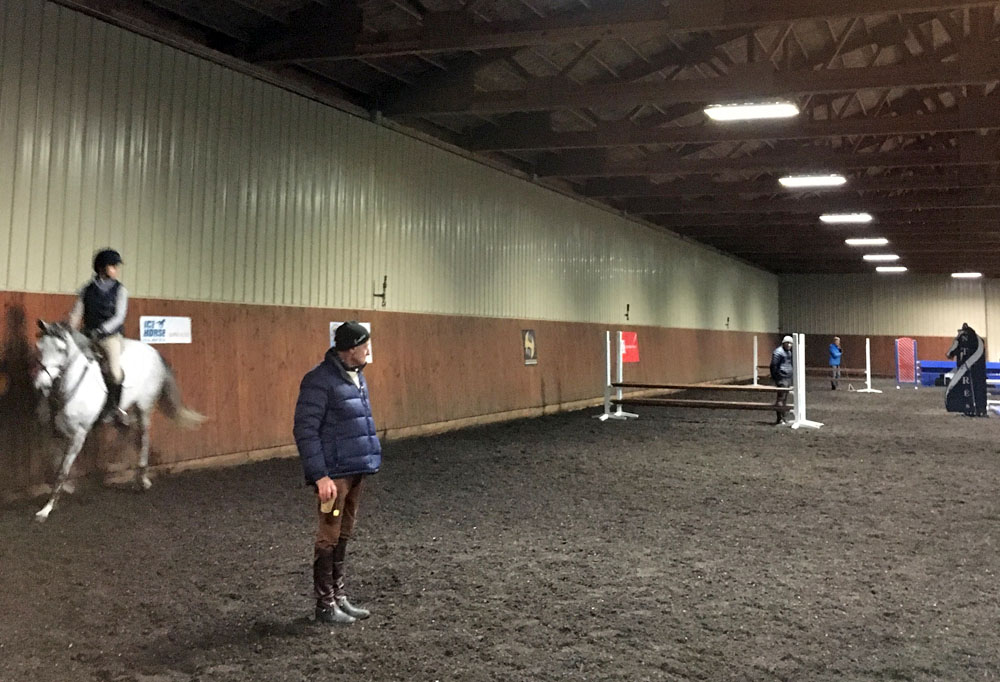
When George Morris stands in the corner, nobody cuts a turn! Photo by Camilla Mortensen
Each session again started with flatwork. “The horse goes in a box,” Morris said. A rectangle. If the horse is against your hand, close your hand. If the horse is against the seat, close the seat. If the horse is against the leg, close the leg.
Impulsion, he pointed out, has little to do with speed. It’s the reach forward, and collection without impulsion is like letting air out of a tire.
In the 4’ group, Morris hopped on Tiffany Martin’s Clio 35 to demonstrate the principles of flatwork from the halt (seat, back, leg, hand) to straightness in flying changes.
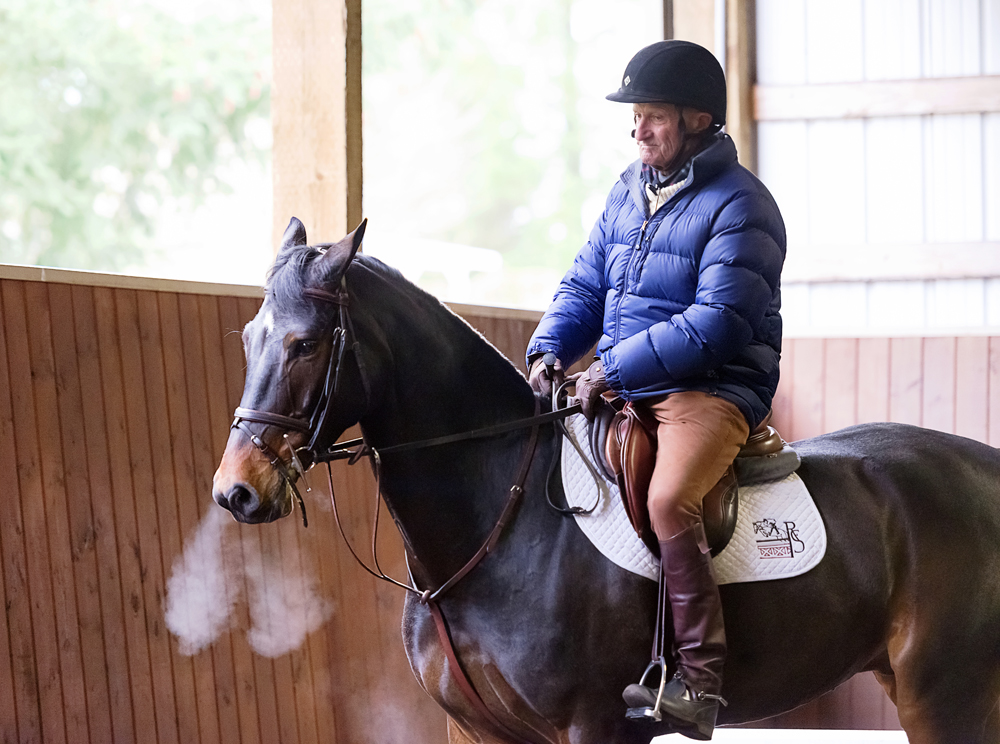
George Morris demonstrating on Tiffany Martin’s Clio 35. Photo by Irina Kuzmina
There was a moment of subdued excitement when Morris quietly called Rich Fellers away from raking the arena footing to free his foot from the stirrup where it had become stuck.
Morris used the moment to explain why it’s important to have tack your clinician can ride in if the teacher needs to get on your horse, pointing out that had the horse spooked and he fallen, he could have been dragged.
Later, when riding Chris Fellers’ mount Cormann, and praising the horse’s rideability, Morris also expounded on the need to not reinvent the wheel when it comes to tack. Keepers are better than the newer slots found on some saddles and he prefers old style, heavier, stirrups, he prophesied.
On the tack note, earlier in the weekend, his attention to detail extended even to martingale placement, telling riders to bring the strap across the wither closer to their saddles, thus making their horses’ necks look longer.
After freeing his foot, Morris simply rode without stirrups.
ADVERTISEMENT
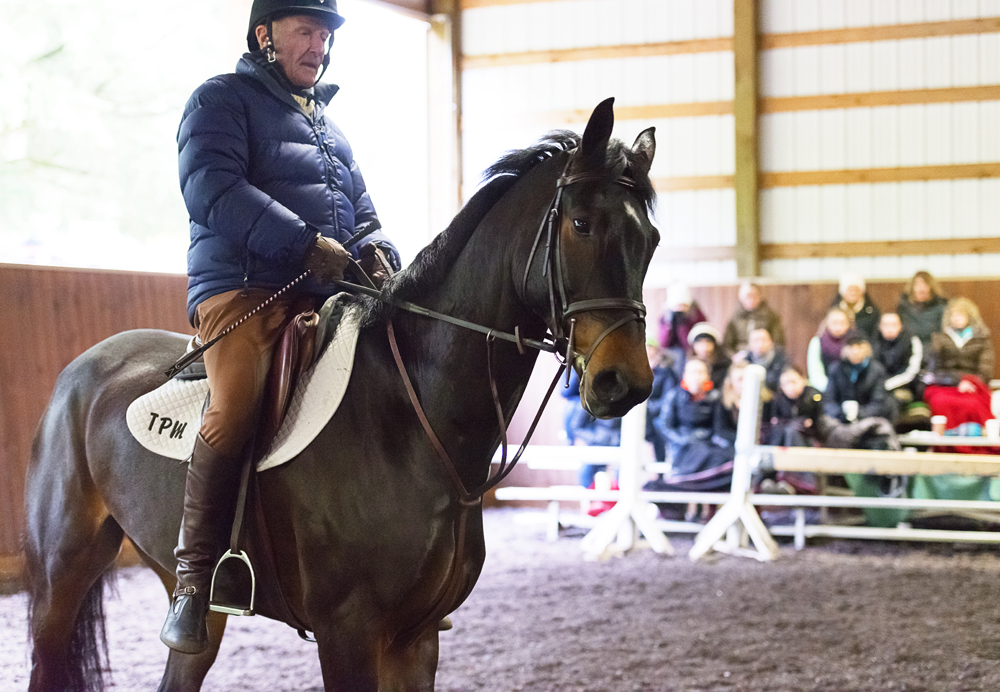
George Morris riding without stirrups on Tiffany Martin’s Clio 35. Photo by Irina Kuzmina
Later on Cormann, Morris demonstrated collection at the canter, and he rode the gelding at a pirouette canter and then demonstrated the beginnings of a canter pirouette, before handing the bay back to Rich Fellers’ son.
Morris said, the grace of the horse is in the hindquarters but so is the resistance “so I do a lot of suppling of the hindquarters.”
Flatwork continued from the previous day’s work on shoulder-in and haunches-in, and Morris added in half-pass zig-zags, saying “a half pass is haunches-in on a diagonal line.” He also continued his discussion of hands, while reminding the riders that riding forward is 70 percent leg and only 30 percent hands.
“I don’t pull; I resist, I fix,” he said. “It’s simple to talk about it, but not easy to do it.”
Morris said, “You don’t get educated hands using draw reins,” and added that he has not touched draw reins in 50 years. The consequences of draw reins are grave he said—a dead mouth, over-flexed and lame.
“The quickest way to cripple a horse is using auxiliary reins,” Morris said, such as a chambon, draw reins or an over-short martingale. “If you work a horse properly, the vets won’t like it,” he laughed as he linked correct riding to soundness.
Ride forward with a driving leg to resisting, restraining hands, Morris said, so the horse cedes his lower jaw and bends at the poll. If a horse doesn’t do that, then it’s impossible to supple him. The idea is simple, he said, but not easy to teach because it’s based so much on feel.
He advocated for short reins, closed fingers, and supple, elastic arms.
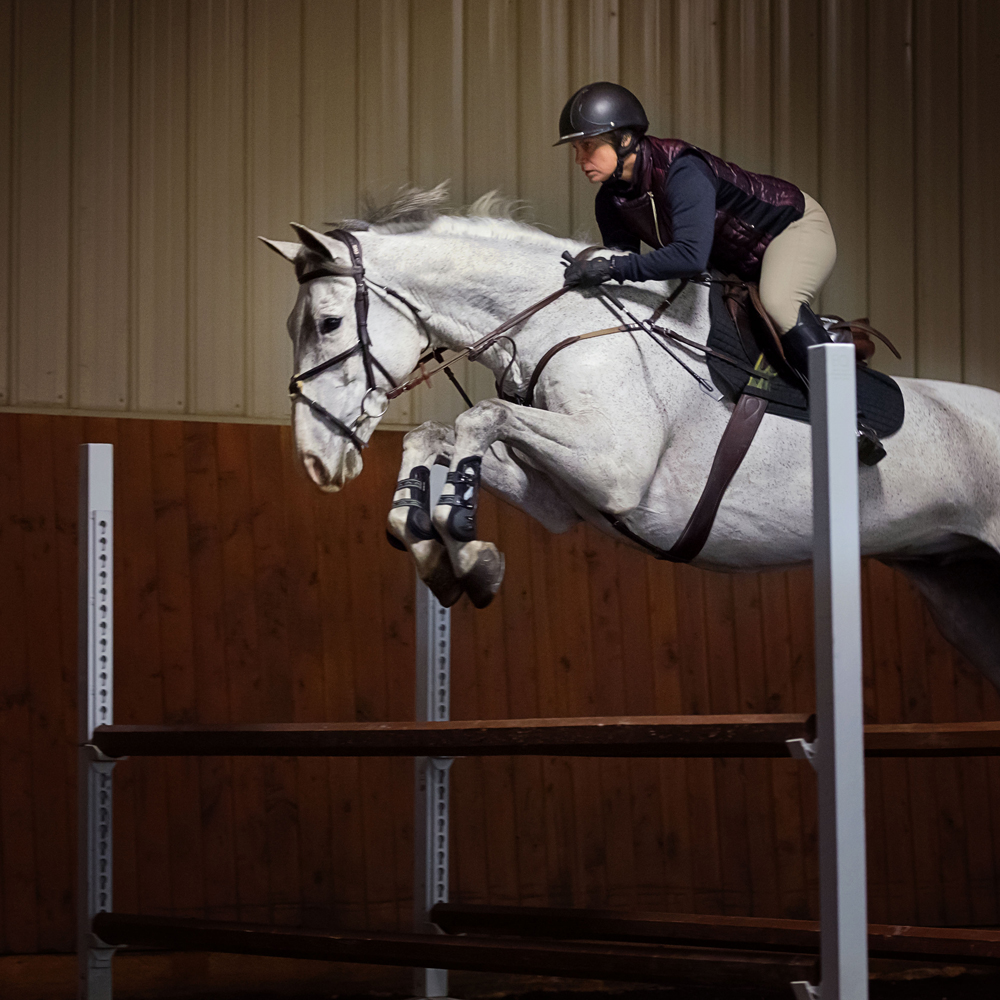
Rehbeccah Burkhart rode Dawny Grey in the clinic. Photo by Irina Kuzmina
Throughout the weekend Morris praised the virtues of the Thoroughbred and compared them to European warmbloods, which he said are slower to learn and lacking “blood” don’t have the natural impulsion that the Thoroughbreds do.
The first jump exercise was a simple 58’ line ridden oxer to vertical or vertical to oxer. Morris had the 4’ group add up and ride the line in five strides. When some of the horses tossed their heads in resistance, Morris said that was a sign the animals were not submissive to the hands. “Close your fingers,” he said, “often when a horse is against the hand, people slip the rein.”
The 4’3” and up group, on the other hand, was asked to ride forward into the line and get four strides, but to get the four in such a way the horses got to the base of the second fence. As the height increased, Morris added a yellow pole on the ground one foot out from vertical. The pole he said helps the horse on the take-off side, but makes it harder on the landing at is a “false optical” and an “educational trap” to get the horse to focus on the top rail.
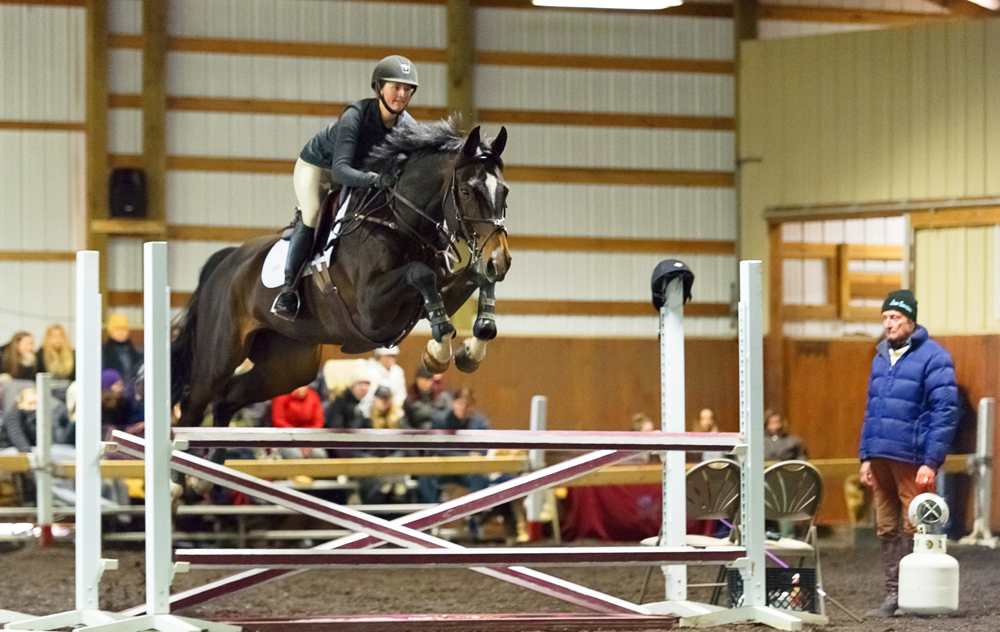
Emma Glaunert navigating one of Morris’ exercises. Photo by Irina Kuzmina
The next set of jumps was a triple bar then a long gallop to the tight turn to the three strides to another three-stride line. “If a horse won’t slow down, stop, back up, then it also won’t turn,” Morris said.
He said, “The distance doesn’t have to be perfect, you have to be able to cope with it.”
Morris often incorporated half turns in reverse into the courses, saying that it helps to collect the horse. He also had riders stop using the wall, calling walls an “aid to the hands.”
ADVERTISEMENT
Morris stressed the need for a forward seat; it’s easier and more restful for the horse, he said, when the rider is inclined forward and off its back.
The last two exercises proved challenging for many of the horse and rider pairs. The first was the triple bar, left in about six strides to a brown panel, rollback to a blue panel, followed by an inside turn. For Fellers’ group the inside turn then took riders back to the triple bar and a repeat of the exercise. The exercise gets horses soft by turning, Morris told the crowd. The fences don’t have to be high, he said, the point is to lighten the horse to the turning aids.
The last line was a triple, oxer, one stride; vertical, one stride; oxer then three strides bending to a wall, and it could be ridden in either direction. Horses that hit rails the first time through were quick to pick up their feet on the next approach.
In the turning exercise, Morris had the 4’ group ride up to the brown panel fence, halt close—chest to the fence, he said—and cluck. “Prevention is better than correction.” The next group didn’t do that prep and three horses refused or ran out.
Morris’ discussion about the safety of jumping proved prophetic. Rider Madeline Bergman rode a tight turn to the triple in the 4’3” and up group, and her horse, Mr. Miracle Man, left out a stride and crashed through the fence. Bergman fell and left the arena in an ambulance (nothing was broken).
Morris was at Bergman’s side after she fell, talking to the rider and monitoring her injuries. When he knew she wasn’t seriously injured, he asked her if she knew why she fell and explained to her what happened.
He later explained to the audience that, “It’s important to know why you fell,” and the knowledge helps a rider’s confidence.
The riders resumed where they had left off with Morris either telling them to repeat the exercise because they or their horses had made and error or praising with “beautiful,” or “thaaaat’s it.”
Watching Rich Fellers on Darco, Morris explained that a distance is always a little bit long or a little bit short. He praised Fellers for his ability to assess the distance and make a decision. A rider must act and react, he said.
Morris ended the clinic saying that he came from a different era, an era, he said, of blood and guts, where at the Rome Olympics multiple horses had a rotational fall.
When you ride a horse, it’s dangerous, he said; when you jump a horse there’s risk. He said he has broken his neck and femur, separated his shoulder, had concussions. “It’s part of the sport, especially when you jump,” he said, adding, “That’s why I am hard on riders and auditors.
“I want a climate of hard discipline,” Morris said. “This sport is never going to be badminton.”
“You are only as great as your horse,” he continued. He said, “I was not the most talented, not the most brave but I never had a bad horse.”
“A great rider like Rich [Fellers] makes a good horse a good plus,” he said, “but you don’t make a good horse a great horse.
“You are not better than your horse.”
Read all about Day 2 of George H. Morris’ Oregon clinic.

